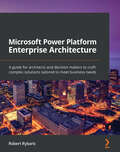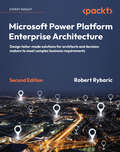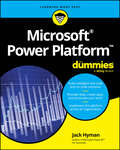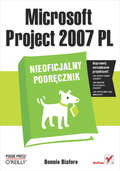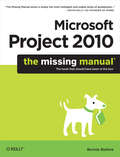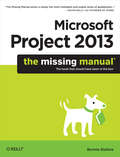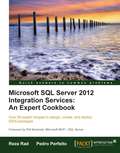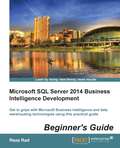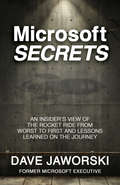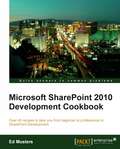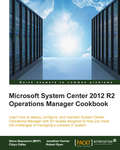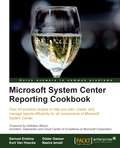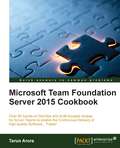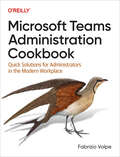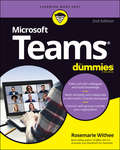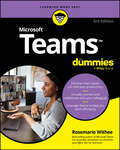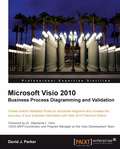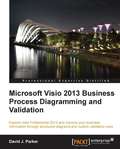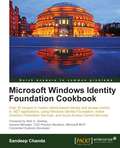- Table View
- List View
Microsoft Power Platform Enterprise Architecture: A guide for architects and decision makers to craft complex solutions tailored to meet business needs
by Robert RybaricGain a 360-degree view of Microsoft Power Platform and combine the benefits of Power Apps, Power BI, Power Automate, Azure, and Dynamics 365 to build an enterprise application platform for your organization Key Features Explore various Microsoft cloud components and find out how they can enhance your Power Platform solutions Get to grips with Microsoft Power Platform's security and extensibility, integration, and data migration models Discover architectural best practices for designing complex enterprise solutions Book Description For forward-looking architects and decision makers who want to craft complex solutions to serve growing business needs, Microsoft Power Platform Enterprise Architecture offers an array of architectural best practices and techniques. With this book, you'll learn how to design robust software using the tools available in the Power Platform suite and be able to integrate them seamlessly with various Microsoft 365 and Azure components. Unlike most other resources that are overwhelmingly long and unstructured, this book covers essential concepts using concise yet practical examples to help you save time. You'll develop the skills you need to architect, design, and manage a complex solution as you follow the journey of a fictitious enterprise customer as they enter the world of Power Platform. Throughout the book, you'll discover how to combine the functionality of Power Apps, Power Automate, Power BI, and Power Virtual Agents with various methodologies to effectively address application lifecycle management, security, and extensibility. Finally, you'll learn how to overcome common challenges in migrating data to and from Microsoft Power Platform using proven techniques. By the end of this book, you'll have the strategic perspective of an enterprise architect to make accurate architectural decisions for your complex Power Platform projects. What you will learn Understand various Dynamics 365 CRM, ERP, and AI modules for creating Power Platform solutions Enhance Power Platform with Microsoft 365 and Azure Find out which regions, staging environments, and user licensing groups need to be employed when creating enterprise solutions Implement sophisticated security by using various authentication and authorization techniques Extend Power Apps, Power BI, and Power Automate to create custom applications Integrate your solution with various in-house Microsoft components or third-party systems using integration patterns Who this book is for This book is for enterprise architects and technical decision makers who want to craft complex solutions using Microsoft Power Platform to serve growing business needs and to stay competitive in the modern IT world. A basic understanding of Microsoft Power Platform will help you to get started with this book.
Microsoft Power Platform Enterprise Architecture: A guide for architects and decision makers to craft complex solutions tailored to meet business needs
by Robert RybaricGain a 360-degree view of Microsoft Power Platform and combine the benefits of Power Apps, Power BI, Power Automate, Azure, and Dynamics 365 to build an enterprise application platform for your organizationKey FeaturesExplore various Microsoft cloud components and find out how they can enhance your Power Platform solutionsGet to grips with Microsoft Power Platform's security and extensibility, integration, and data migration modelsDiscover architectural best practices for designing complex enterprise solutionsBook DescriptionFor forward-looking architects and decision makers who want to craft complex solutions to serve growing business needs, Microsoft Power Platform Enterprise Architecture offers an array of architectural best practices and techniques. With this book, you’ll learn how to design robust software using the tools available in the Power Platform suite and be able to integrate them seamlessly with various Microsoft 365 and Azure components. Unlike most other resources that are overwhelmingly long and unstructured, this book covers essential concepts using concise yet practical examples to help you save time. You’ll develop the skills you need to architect, design, and manage a complex solution as you follow the journey of a fictitious enterprise customer as they enter the world of Power Platform. Throughout the book, you’ll discover how to combine the functionality of Power Apps, Power Automate, Power BI, and Power Virtual Agents with various methodologies to effectively address application lifecycle management, security, and extensibility. Finally, you'll learn how to overcome common challenges in migrating data to and from Microsoft Power Platform using proven techniques. By the end of this book, you’ll have the strategic perspective of an enterprise architect to make accurate architectural decisions for your complex Power Platform projects.What you will learnUnderstand various Dynamics 365 CRM, ERP, and AI modules for creating Power Platform solutionsEnhance Power Platform with Microsoft 365 and AzureFind out which regions, staging environments, and user licensing groups need to be employed when creating enterprise solutionsImplement sophisticated security by using various authentication and authorization techniquesExtend Power Apps, Power BI, and Power Automate to create custom applicationsIntegrate your solution with various in-house Microsoft components or third-party systems using integration patternsWho this book is forThis book is for enterprise architects and technical decision makers who want to craft complex solutions using Microsoft Power Platform to serve growing business needs and to stay competitive in the modern IT world. A basic understanding of Microsoft Power Platform will help you to get started with this book.
Microsoft Power Platform Enterprise Architecture: Design tailor-made solutions for architects and decision makers to meet complex business requirements, 2nd Edition
by Robert Rybaric Dennis Neer Dr. Ram Singh Shabbir H. Mala Leslie AndrewsThis book enables you to design tailor-made enterprise solutions using the latest models, methodologies, and patterns for your projects. It harnesses the capabilities of the Power Platform, Azure, and Dynamics 365 to create robust solutions. In this new edition, you can work with the latest technologies such as Dataverse and Power Portals to take your solutions to the next level.Purchase of the print or Kindle book includes a free eBook in PDF format.Expert insights"This book provides a solid understanding of how Microsoft 365 and Power Platform work together and offers detailed information on the architecture. It blends a theoretical approach with real-world scenarios to bring the theories to life and demonstrates how architecture operates in practice."—Mary Angiela Cerbolles, Dual Microsoft MVP, productivity analyst"What I really like about this book is that it is well structured and easy to follow, using practical examples to illustrate key concepts throughout. I highly recommend it!"—Thomas Rice, 16x Microsoft Certified Solutions ArchitectKey FeaturesDesign solution architecture utilizing the full Microsoft ecosystem, now with diagrams to explain the Microsoft cloud structureDevelop solutions with a wide range of customization tools and techniques, updated for the best practices regarding APIs and plug-insOptimize solution architecture using the latest ALM best practices and integration models, following example enterprise requirementsAbout the bookThis book is for enterprise architects and decision makers who design solutions for complex business requirements. It teaches you how to use architectural best practices and methodologies to optimize an enterprise-grade solution.You'll gain an understanding of the tools available in the Power Platform suite and how to integrate them seamlessly with various Microsoft 365 and Azure components to create a tailor-made solution. Progressing through the book, you'll discover how to address application lifecycle management, security, extensibility, and data migration. This includes Power BI, which often requires a separate approach to the rest of the Power Platform.This book provides you with practical, essential, and concise information. It follows a complete, end-to-end example in every chapter, with diagrams that illustrate the intricacies of Microsoft cloud structure. It has been created by an experienced enterprise architect who actively creates solutions using Microsoft technology.By the end of this book, you'll have the strategic perspective of an enterprise architect to make accurate architectural decisions for your complex Power Platform projects.Who this book is forIf you're an enterprise architect or technical decision maker looking to design complex solutions using Microsoft Power Platform, this is the book for you. Familiarity with Microsoft Power Platform and Azure services will be required to follow along.
Microsoft Power Platform For Dummies
by Jack A. HymanBuild business intelligence with insight from a professional Microsoft Power Platform For Dummies covers the essentials you need to know to get started with Microsoft Power Platform, the suite of business intelligence applications designed to make your enterprise work smarter and more efficiently. You'll get a handle on managing and reporting data with Power BI, building no-code apps with Power Apps, creating simple web properties with Power Pages, and simplifying your day-to-day work with Power Automate. Written by a business consultant who's helped some of the world's largest organizations adopt, manage, and get work done with Power Platform, this book gets you through your work without working too hard to figure things out. Discover the tools that come with Power Platform and how they can help you build business intelligence Manage data, create apps, automate routine tasks, create web pages, and beyond Learn the current best practices for launching Power Platform in an organization Get step-by-step instructions for navigating the interface and setting up your tools This is a great quick-start guide for anyone who wants to leverage Power Platform's BI tools.
Microsoft Project 2007 PL. Nieoficjalny podr?cznik
by Bonnie BiaforeJak okre?li? bud?et projektu?Jak stworzy? harmonogram projektu?Jak monitorowa? jego wykonanie? Czy zd??ysz przeczyta? t? ksi??k? do ko?ca przysz?ego tygodnia? Czy zd??ysz w tym czasie rozwi?za? nagl?cy problem? Czy projekt, który realizujesz, nie przekroczy bud?etu? Czy aby na pewno twoi wspó?pracownicy ko?cz? swoje zadania zgodnie z harmonogramem? Na te i wiele innych pyta? ci??ko jest odpowiedzie? bez czasoch?onnych analiz. A i tak ka?da odpowied? z pewno?ci? b?dzie obarczona jakim? b??dem. Istnieje jednak rozwi?zanie, które pozwoli Ci zapanowa? nad skomplikowanymi projektami w sensowny i niek?opotliwy sposób. To rozwi?zanie ma posta? narz?dzia Microsoft Project 2007."Microsoft Project 2007 PL. Nieoficjalny podr?cznik" to rewelacyjna propozycja, oszcz?dzaj?ca Twój czas, odkryje przed Tob? wszystkie swoje tajemnice i da Ci do r?ki u?yteczne funkcje. Nauczysz si? planowa? projekt, a tak?e okre?la? zadania oraz czas pracy. Po przeczytaniu tej ksi??ki b?dziesz wiedzia?, jak przygotowa? plan projektu, który b?dzie przejrzysty, czytelny i - co najwa?niejsze - ?atwy w utrzymaniu, aktualizowaniu i codziennej analizie. Autor pokazuje, w jaki sposób zidentyfikowa? zasoby oraz przypisa? je do zada? oraz jak okre?li? bud?et projektu. Podczas lektury zdob?dziesz tak?e wiedz? na temat sposobów monitorowania projektu, pracy z wieloma projektami czy te? wykorzystywania danych z Microsoft Project w innych programach. Z pewno?ci? zainteresuje Ci? rozdzia? po?wi?cony szablonom i makrom, które pozwol? Ci zautomatyzowa? i przy?pieszy? cz?sto wykonywane zadania. Zarz?dzanie projektamiPlanowanie projektuIdentyfikowanie zada?Przygotowanie harmonogramu projektuTworzenie elastycznego, ?atwego do zarz?dzania harmonogramuOrganizowanie zespo?u, identyfikacja koniecznych zasobówWi?zanie zasobów z zadaniami?ledzenie wykonania harmonogramuZarz?dzanie zmianami w projekcieRaportowaniePraca z wieloma projektamiWykorzystanie makrZastosowanie szablonów Zarz?dzanie projektem mo?e by? sprawne i przyjemne!
Microsoft Project 2010: The Missing Manual (The\missing Manual Ser.)
by Bonnie BiaforeMicrosoft Project is brimming with features to help you manage any project, large or small. But learning the software is only half the battle. What you really need is real-world guidance: how to prep your project before touching your PC, which Project tools work best, and which ones to use with care. This book explains it all, helping you go from project manager to project master.Get a project management primer. Discover what it takes to handle a project successfullyLearn the program inside out. Get step-by-step instructions for Project Standard and Project ProfessionalBuild and refine your plan. Put together your team, schedule, and budgetAchieve the results you want. Build realistic schedules, and learn how to keep costs under controlTrack your progress. Measure your performance, make course corrections, and manage changesUse Project's power tools. Customize Project's features and views, and transfer info directly between Project and other programs
Microsoft Project 2013: The Missing Manual (The\missing Manual Ser.)
by Bonnie BiaforeGet up to speed on Microsoft Project 2013 and learn how to manage projects large and small. This crystal-clear book not only guides you step-by-step through Project 2013’s new features, it also gives you real-world guidance: how to prep a project before touching your PC, and which Project tools will keep you on target. With this Missing Manual, you’ll go from project manager to Project master.The important stuff you need to knowLearn Project 2013 inside out. Get hands-on instructions for the Standard and Professional editions.Start with a project management primer. Discover what it takes to handle a project successfully.Build and refine your plan. Put together your team, schedule, and budget.Achieve the results you want. Build realistic schedules with Project, and learn how to keep costs under control.Track your progress. Measure your performance, make course corrections, and manage changes.Create attractive reports. Communicate clearly to stakeholders and team members using charts, tables, and dashboards.Use Project’s power tools. Customize Project’s features and views, and transfer info via the cloud, using Microsoft SkyDrive.
Microsoft SQL Server 2012 Integration Services: An Expert Cookbook
by Pedro Perfeito Reza RadThis book is written in a simple, easy to understand format with lots of screenshots and step-by-step explanations. If you are an SQL database administrator or developer looking to explore all the aspects of SSIS and need to use SSIS in the data transfer parts of systems, then this is the best guide for you. Basic understanding of working with SQL Server Integration Services is required.
Microsoft SQL Server 2014 Business Intelligence Development Beginner's Guide
by Reza RadIn Detail Take advantage of the real power behind the BI components of SQL Server 2014, Excel 2013, and SharePoint 2013 with this hands-on book. This book will give you a competitive advantage by helping you to quickly learn how to design and build BI system with Microsoft BI tools. This book starts with designing a data warehouse with dimensional modeling, and then looks at creating data models based on SSAS multidimensional and Tabular technologies. It will illustrate how to use SSIS for ETL, and MDS and DQS for data governance and data quality. The book is packed with real-world examples that will give you a good understanding of the BI and DW components of SQL Server 2014, Excel 2013, and SharePoint 2013. Approach Written in an easy-to-follow, example-driven format, there are plenty of step-by-step instructions to help get you started! The book has a friendly approach, with the opportunity to learn by experimenting. Who this book is for If you are a BI and Data Warehouse developer new to Microsoft Business Intelligence, and looking to get a good understanding of the different components of Microsoft SQL Server for Business Intelligence, this book is for you. It’s assumed that you will have some experience in databases systems and T-SQL. This book is will give you a good upshot view of each component and scenarios featuring the use of that component in Data Warehousing and Business Intelligence systems.
Microsoft Secrets: An Insider’s View of the Rocket Ride from Worst to First and Lessons Learned on the Journey
by Dave JaworskiA great deal has been written about Steve Jobs and Apple. Not nearly as much has been produced about Bill Gates and Microsoft, especially in the ten-year period that Dave Jaworski was at Microsoft. Microsoft was the company that drove the hardest and built the fastest. He was there during this rapid rise to the top. Dave kept meticulous notes and took lots of photos and documented the risks taken, the dreams shared, the lessons learned, the hopes realized, and the mistakes made. Many of the issues at the time are similar to issues confronting leaders in business today. All can learn from Microsoft’s past. Dave also details several secrets—some only his family knows. Some of these secrets were known to only a handful of people within the company at a time when it went through its explosive growth period: like the secret recipe for Coca-Cola or Colonel Sanders’ chicken recipe, these secrets were literally changing the competitive landscape in the technology industry and were rewriting the business rules of the day. Understanding these secrets and the thinking behind them can provide strategic insights and advantages to professionals and their businesses. Better still, they can help them define their own secrets to accelerate them past competitors and over hurdles to success.
Microsoft Server & Tools
by Marco Iansiti Alain SerelsIn 2011, Microsoft's Server & Tools Business (STB) was large, fast growing and highly profitable on the strength of traditional packaged product lines led by the Windows Server operating system. Even as the current packaged business was performing exceptionally well, Microsoft's leadership understood that cloud based solutions would become more prevalent in the future. As the newly appointed President of STB, Satya Nadella had to find a balance between managing the current packaged business and building the cloud offering.
Microsoft SharePoint 2010 development cookbook
by Ed MustersThe plan of the book is to build a relationship with the Author as your personal guide through the most common "pattern" of SharePoint development. In cookbook style, you will be led carefully step by step through a comprehensive set of recipes. The practical example starts quickly and builds logically throughout the chapters to create a common theme. You will be developing coding techniques that you will be able to apply to the real world. In fact, this book will train you for the first SharePoint development project you will join. This book is written for the ASP.NET developer who wants to get to the goal of "professional" SharePoint 2010 developer as quickly as possible, by learning the most important practical aspects of development that will be used in the real world.
Microsoft System Center 2012 R2 Operations Manager Cookbook
by Steve Beaumont Jonathan HornerIf you are tasked with monitoring the IT infrastructure within your organization, this book demonstrates how System Center 2012 R2 Operations Manager offers a radical and exciting solution to modern administration.
Microsoft System Center Reporting Cookbook
by Samuel Erskine Dieter GasserThis book is for IT professionals who are responsible for producing reports using the data from System Center components. Basic knowledge of Microsoft System Center technologies is assumed.
Microsoft Team Foundation Server 2015 Cookbook
by Tarun AroraOver 80 hands-on DevOps and ALM-focused recipes for Scrum Teams to enable the Continuous Delivery of high-quality Software... Faster! About This Book * Release high quality, reliable software quickly through building, testing, and deployment automation * Improve the predictability, reliability, and availability of TFS in your organization by scheduling administration and maintenance activities * Extend, customize, and integrate tools with TFS, enabling your teams to manage their application lifecycles effectively Who This Book Is For This book is aimed at software professionals including Developers, Testers, Architects, Configuration Analysts, and Release Managers who want to understand the capabilities of TFS to deliver better quality software faster. A working setup of TFS 2015 and some familiarity with the concepts of software life cycle management is assumed. What You Will Learn * Creating a Team Project with Dashboards, Assigning License, Adding users, and Auditing Access * Setting up a Git repository in an existing TFVC-based Team Project * Setting up branch policies and conducting Pull requests with code reviews * Mapping, assigning and tracking work items shared by multiple teams * Setting up and customizing Backlogs, Kanban board, Sprint Taskboard, and dashboards * Creating a Continuous Integration, Continuous Build, and Release Pipeline * Integrating SonarQube with TFBuild to manage Technical Debt * Triggering Selenium Web Tests on a Selenium Test Grid using TFBuild * Using Visual Studio Team Services Cloud load testing capability with new Build framework * Extending and customizing the capabilities of Team Foundation Server using API and Process Editor In Detail Team Foundation Server (TFS) allows you to manage code repositories, build processes, test infrastructure, and deploy labs. TFS supports your team, enabling you to connect, collaborate, and deliver on time. Microsoft's approach to Application Lifecycle Management (ALM) provides a flexible and agile environment that adapts to the needs of your team, removes barriers between roles, and streamlines processes. The book introduces you to creating and setting up team projects for scrum teams. You'll explore various source control repositories, branching, and merging activities, along with a demonstration of how to embed quality into every code check-in. Then, you'll discover agile project planning and management tools. Later, emphasis is given to the testing and release management features of TFS which facilitate the automation of the release pipeline in order to create potentially shippable increments. By the end of the book, you'll have learned to extend and customize TFS plugins to incorporate them into other platforms and enable teams to manage the software lifecycle effectively. Style and approach This book is a recipe-based guide that uses a problem-solution format to call out inefficiencies in the software development lifecycle and then guides you, step-by-step, on how you can use Team Foundation Server to your advantage in those areas.
Microsoft Teams Administration Cookbook: Quick Solutions for Administrators in the Modern Workplace
by Fabrizio VolpeMicrosoft Teams is used in hundreds of thousands of organizations to help keep remote and hybrid workplaces with dispersed workforces running smoothly. But while Microsoft Teams can seem easy for the user, Teams administrators must stay on top of a wide range of topics, including device administration techniques, quality benchmarks, and security and compliance measures.With this handy cookbook, author Fabrizio Volpe provides a clear, concise overview of administrative tasks in Teams-along with step-by-step recipes to help you solve many of the common problems that system administrators, project managers, solution architects, and IT consultants may face when configuring, implementing, and managing Microsoft Teams. Think of this book as a detailed, immensely practical cheat sheet for Microsoft Teams administrators.Recipes in the book will show you how to:Apply Teams best practices, compliance, and securityAutomate administrative tasksSuccessfully deploy TeamsImplement Teams collaborationDeploy and manage Microsoft Teams RoomsLeverage the monitoring, productivity, and accessibility featuresForesee roadblocks in migrations to Teams and Teams VoiceOptimize Teams on virtual machines
Microsoft Teams For Dummies
by Rosemarie WitheeWork seamlessly together with Microsoft Teams It was only a matter of time before Microsoft 365 built an actual virtual office. And Microsoft Teams is it, rocketing from 13 to 75 million daily users in a single year. The new edition of Microsoft Teams For Dummies gives you an in-depth introductory tour through the latest version of the app, exploring the many different ways you can chat, call, meet, work remotely, and collaborate with others in real time—whether you’re using it as an all-in-one tool for working from home or as an extension to your brick-and-mortar office. Available as a stand-alone app or as part of Microsoft 365, it allows you to work seamlessly with almost any other Microsoft app. The friendly onboarding provided by this book takes you from the basics of file-sharing, organizing teams, and using video to must-have insights into less obvious functionality, such as posting the same message to multiple channels, muffling background noise (useful if you’re working from home!), and choosing more than one feed to concentrate on when video-conferencing (allowing you to pay attention to the speaker and your team members at the same time). As well as clueing you in on how things work, you’ll also find advice on the most effective ways of using them, with best-practices recommendations and tips on integrating Microsoft Teams into your existing workflows. Set up the interface Communicate on chat and video, inside and outside your org Integrate Microsoft Teams with your other Office apps Optimize your approach to meetings, working across large teams, and more! Whether you’re using Microsoft Teams for work, within your family, or for a collaborative hobby, you’ll find everything you need to get everyone on the same page in the same virtual room.
Microsoft Teams For Dummies
by Rosemarie WitheeUnlock the full power of Microsoft Teams, including brand-new AI functionality, with your friends at For Dummies Looking for a fast and easy guide to Microsoft Teams, the collaboration software used by millions of people and companies around the world? In Microsoft Teams For Dummies, 3rd edition, you'll find the must-know tips, hidden tricks, and handy hacks you need to help you rock your workday and get things done lightning-fast. You'll learn how to incorporate Teams into your everyday workflow and use functionality like chatting, file sharing, team organization, videochat, and more. You'll even learn how to use Microsoft's brand-new AI companion Copilot to help you improve your processes and productivity. You'll find out how to: Connect with colleagues and collaborate remotely, from across the hall or from the other side of the world Use little-known Teams features to help you supercharge your productivity and get more done in a day Customize your Teams installation and make it work better for you and your teammates An engaging and effective roadmap to one of Microsoft's most popular apps, Microsoft Teams For Dummies is a must-read for everyone who uses—or wants to use—this powerful software at work or anywhere else. Grab a copy today!
Microsoft Visio 2010 Business Process Diagramming and Validation
by David John ParkerA focused tutorial, this book provides a range of practical examples with downloadable code, showing you how to create business process diagramming templates with Visio and enabling you to effectively visualize business information. It draws on real business examples and needs, and covers all the new features of Visio 2010 Premium Edition. If you are a Microsoft Visio 2010 Premium Edition user or developer who wants to get to grips with both the basic features of Visio 2010 and the new Validation Rules in this edition, then this book is for you. A working knowledge of Microsoft Visio, and optionally .NET for the add-in code, is required, though previous knowledge of business process diagramming is not necessary. More experienced Visio users will gain valuable knowledge for building add-ins and creating and publishing rules. If you want to achieve results from Visio 2010 beyond the ordinary out-of-the-box features, then this book is ideal for you. Although this book covers the Premium Edition, much of the book is still useful if you are a Visio 2010 Standard Edition or Professional Edition user.
Microsoft Visio 2013 Business Process Diagramming and Validation
by David J. ParkerMicrosoft Visio 2013 Business Process Diagramming and Validation provides a comprehensive and practical tutorial including example code and demonstrations for creating validation rules, writing ShapeSheet formulae, and much more.If you are a Microsoft Visio 2013 Professional Edition power user or developer who wants to get to grips with both the essential features of Visio 2013 and the validation rules in this edition, then this book is for you. A working knowledge of Microsoft Visio and optionally .NET for the add-on code is required, though previous knowledge of business process diagramming is not necessary. More experienced Visio users will gain valuable knowledge regarding building add-ons and creating and publishing rules. If you want to achieve results from Visio 2013 beyond the ordinary out-of-the-box features, then this book is ideal for you. Microsoft Visio 2013 Business Process Diagramming and Validation provides a comprehensive and practical tutorial including example code and demonstrations for creating validation rules, writing ShapeSheet formulae, and much more.
Microsoft Windows Identity Foundation Cookbook
by Sandeep ChandaThis book is written in a simple, easy to understand format, with lots of screenshots and step-by-step explanations.If you are a .NET developer looking forward to building access control in your applications using claims-based identity, then this is the best guide for you. This book is also an excellent choice for professionals and IT administrators trying to enable Single Sign-On across applications within the enterprise, and in the cloud spanning interoperable platforms. No previous knowledge on the subject is necessary, however a strong foundation in the C# programming language and .NET Framework 4.0 is expected. A good understanding of authentication and authorization concepts (Windows and Forms based) in .NET would also help
Microsoft Xbox: Changing the Game?
by Andrei HagiuIn September 1999, the Microsoft Xbox team was wondering which strategic choices would give it the best chance against the upcoming Sony PlayStation 2. Initially called "Project Midway" within Microsoft, the console project was intended to counter the perceived threat to the Windows franchise posed by Sony expanding the original PlayStation into a broad entertainment platform with the PlayStation 2. Seamus Blackley--the chief instigator for the Xbox within Microsoft--and some of his colleagues were on a flight to Austin, Texas, where they had an appointment with Michael Dell, CEO of Dell Computer. The purpose of the visit was to convince Dell to manufacture Xbox videogame consoles running Microsoft software. Indeed, the team intended to produce a machine somewhere between a standalone videogame console and a PC tailored to play videogames. It remained unclear, however, where along the spectrum from dedicated console to PC Microsoft should position the Xbox. Would it be an open platform like the PC in the sense that independent developers could publish games on it with no restrictions and without having to pay royalties? Who would produce consoles and under what arrangements? What features should the console include, and how would it be priced to consumers? The home videogame industry had been born in the 1970s during the Atari "golden age", then collapsed suddenly in 1983. It was reborn at the end of the 1980s under Nintento's leadership, which was then challenged for a few years by Sega, only to be conquered by Sony's original PlayStation. And along the way, some companies such as 3DO had tried unsuccessfully to change the prevalent business models. This tumultuous 25-year history might provide Blackley and his colleagues with some useful tips on how best to enter the market.
Microsoft adCenter
by Peter A. Coles Benjamin EdelmanMicrosoft considers alternatives to expand its presence in online advertising, especially text-based pay-per-click advertising. Google dominates, and it is unclear how Microsoft can grow, despite considerable technical and financial resources. Microsoft considers a set of alternatives, each with clear benefits but also serious challenges.
Microsoft and Metro: Foreign Investors in China and India
by Tarun Khanna Elliott N. WeissThis chapter looks at what it takes for multinationals to succeed in China and India using the cases of Microsoft in China and the German firm, Metro Cash & Carry, in India.
Microsoft in 2002
by David B. Yoffie Carl Johnston Michael G. Rukstad Tyrrell LevineExamines Microsoft's strategy and competitive position as it prepares to launch Windows XP. The discussion explores how Microsoft builds and sustains its competitive edge.
